Indie music merchandise is evolving rapidly, driven by trends in sustainability, personalization, and digital innovation. This article explores the latest market insights, the challenges faced by indie artists, and the regional influences shaping consumer preferences. Additionally, it examines successful marketing strategies that create unique brand identities and foster community engagement.
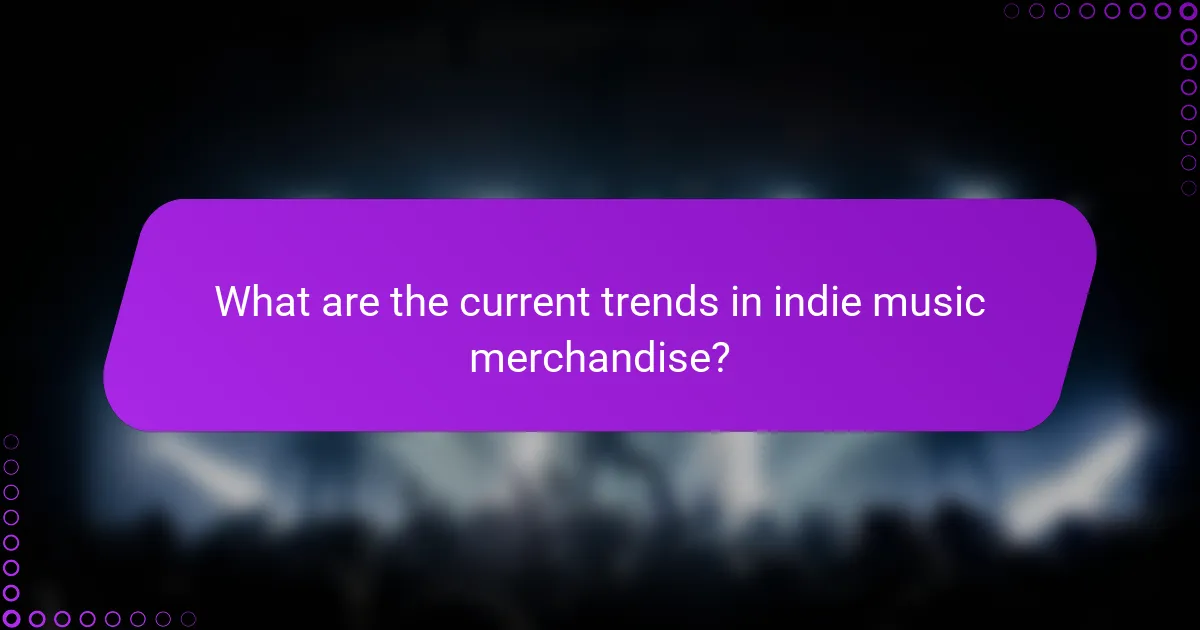
What are the current trends in indie music merchandise?
Indie music merchandise trends focus on sustainability, personalization, and digital integration. Eco-friendly materials are increasingly popular, reflecting consumer demand for responsible production. Customizable items allow fans to express individuality, enhancing connection to artists. Additionally, digital merchandise, such as NFTs, is gaining traction, offering unique ownership experiences.
How has consumer behavior shifted in the indie music merchandise market?
Consumer behavior in the indie music merchandise market has shifted towards personalized, sustainable, and digital experiences. Fans increasingly seek unique items that reflect their identity and support their favorite artists.
The rise of e-commerce has enabled artists to connect directly with consumers, increasing demand for exclusive merchandise. Limited edition releases and collaborations with local artists have become popular, enhancing the perceived value of products.
Sustainability is a growing concern, with many consumers favoring eco-friendly materials and ethical production practices. This trend aligns with the values of the indie music community, which often emphasizes social responsibility.
Additionally, the integration of technology has transformed how fans engage with merchandise. Augmented reality experiences and interactive online platforms are enhancing the shopping experience, making it more immersive and engaging for consumers.
Which merchandise categories are gaining popularity among indie artists?
Indie artists are increasingly focusing on eco-friendly merchandise, apparel collaborations, and digital products. These categories reflect a shift towards sustainability, creativity, and fan engagement. Eco-friendly items, such as biodegradable phone cases and reusable bags, appeal to environmentally conscious consumers. Apparel collaborations with local designers foster unique fashion statements. Digital products, including exclusive music downloads and virtual concert tickets, enhance the connection with fans.
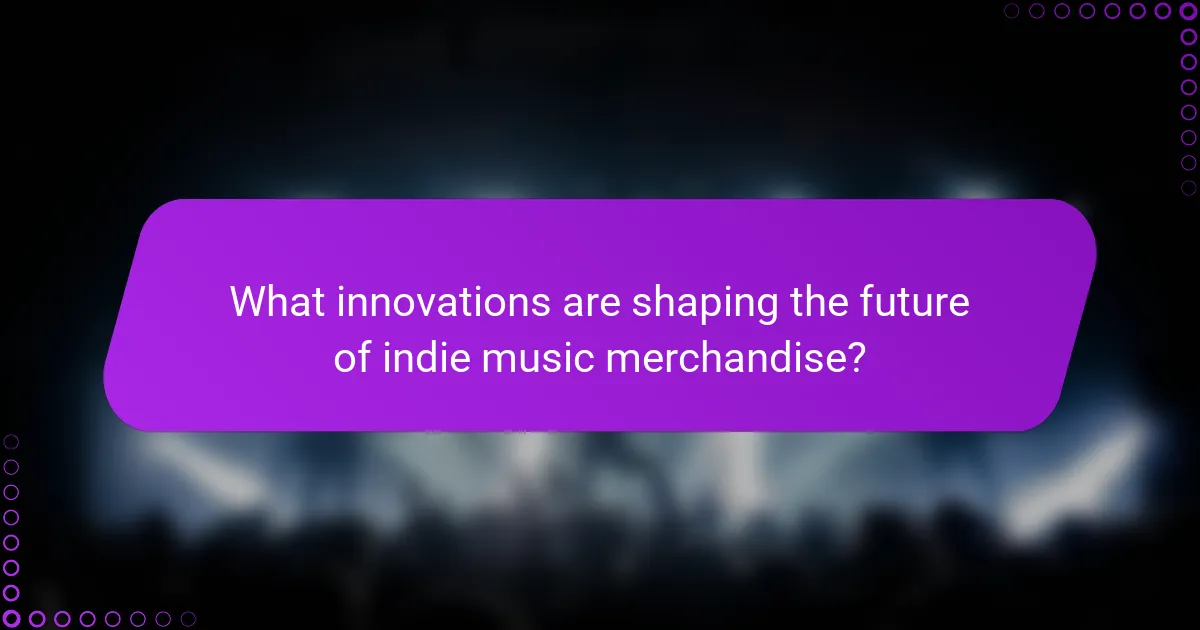
What innovations are shaping the future of indie music merchandise?
Innovations shaping the future of indie music merchandise include personalized products, eco-friendly materials, and digital integration. Artists leverage platforms for direct sales, enhancing fan engagement. Unique attributes like limited edition items and collaborations with local artists create exclusivity. As a result, indie merchandise is evolving to reflect sustainability and community connection.
How are technology and e-commerce transforming merchandise sales?
Technology and e-commerce are revolutionizing indie music merchandise sales by enhancing accessibility and personalization. Online platforms enable artists to reach global audiences, while data analytics inform inventory decisions and marketing strategies.
Innovations such as print-on-demand services reduce upfront costs, allowing artists to offer unique designs without significant investment. Social media and influencer partnerships drive engagement, creating communities around merchandise.
As a result, indie artists can cultivate brand loyalty and diversify revenue streams through exclusive merchandise offerings. This transformation reflects a shift towards a more interactive and consumer-driven market, where fans play a vital role in shaping merchandise trends.
What role do social media platforms play in promoting indie merchandise?
Social media platforms significantly enhance the visibility and sales of indie merchandise. They provide artists with direct access to audiences, enabling targeted marketing strategies. Platforms like Instagram and TikTok allow for creative promotion through visual content and viral trends. This fosters community engagement and drives merchandise sales, particularly among younger demographics. Furthermore, social media analytics offer insights into consumer behavior, helping indie brands refine their marketing approaches.
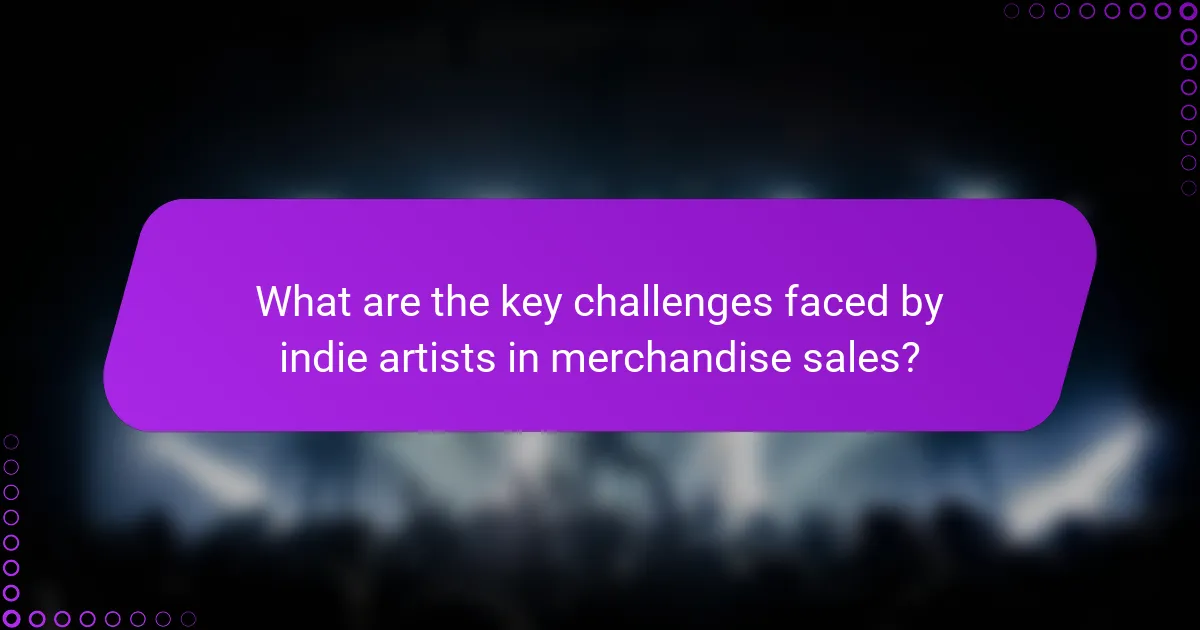
What are the key challenges faced by indie artists in merchandise sales?
Indie artists face several key challenges in merchandise sales, including limited marketing resources, competition from established brands, and difficulties in inventory management. These factors hinder their ability to effectively reach audiences and maximize sales. Additionally, fluctuating consumer preferences and the need for unique designs add complexity to their merchandise strategies.
How do production costs impact pricing strategies for indie merchandise?
Production costs significantly influence pricing strategies for indie merchandise by determining profit margins and competitive positioning. Higher production costs may lead to increased prices, potentially limiting sales volume. Conversely, lower costs can enable more competitive pricing, attracting a broader audience. Indie artists often balance quality and affordability to maintain brand integrity while maximizing revenue. Understanding production costs helps in crafting effective pricing strategies that align with market trends and consumer expectations.
What logistical issues do indie artists encounter when distributing merchandise?
Indie artists face several logistical issues when distributing merchandise, including limited funding, inventory management, and shipping challenges. These factors can hinder their ability to reach audiences effectively.
Limited funding restricts indie artists from investing in high-quality merchandise or large inventory. As a result, they often struggle to meet demand during peak sales periods.
Inventory management becomes complex due to fluctuating demand and storage constraints. Many indie artists lack the resources to track inventory effectively, leading to overstock or stockouts.
Shipping challenges arise from high costs and logistical coordination. Indie artists may face delays or increased expenses when using third-party fulfillment services, impacting customer satisfaction and sales.
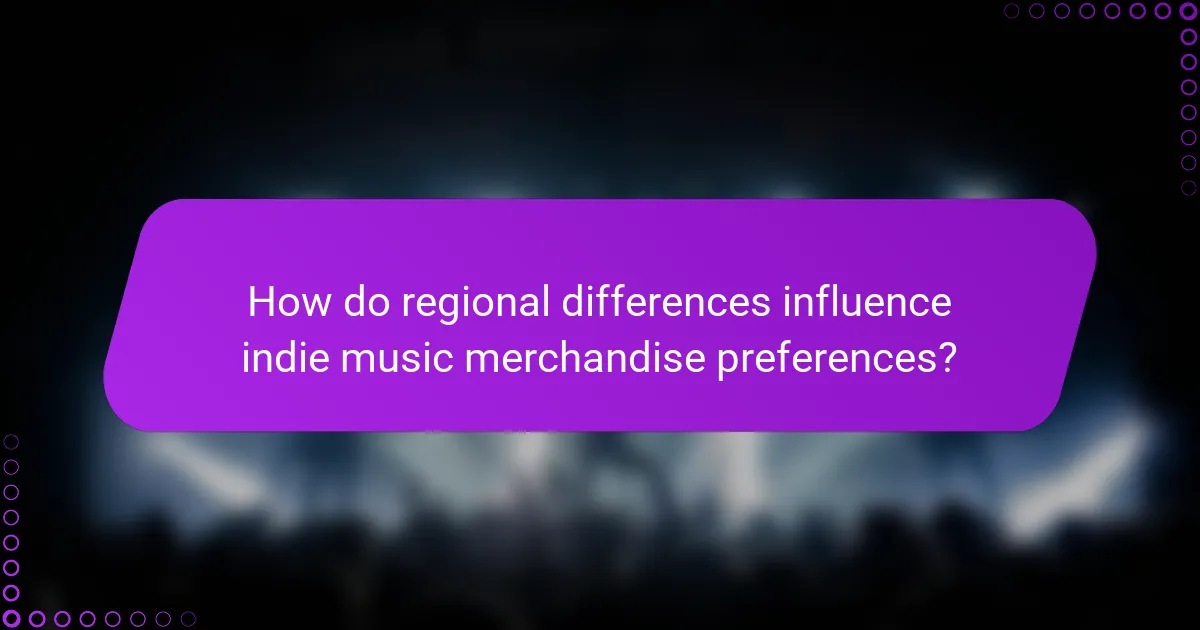
How do regional differences influence indie music merchandise preferences?
Regional differences significantly shape indie music merchandise preferences by influencing local tastes, cultural values, and purchasing behavior. For instance, urban areas may favor limited edition items, while rural regions might prefer practical merchandise.
Cultural influences determine the types of designs and themes popular in various regions. For example, merchandise reflecting local art styles or music scenes often resonates more with consumers.
Economic factors also play a role; regions with higher disposable income may see a demand for premium products. Conversely, areas with tighter budgets may lean towards affordable options.
Lastly, social media trends can vary by region, impacting which merchandise styles gain popularity. Local influencers can sway preferences, leading to unique merchandise trends within different communities.
Which merchandise formats are favored in different cultural contexts?
Different cultural contexts favor various indie music merchandise formats, such as apparel, vinyl records, and digital downloads. In North America, apparel like t-shirts and hoodies are popular due to their visibility and wearability. In Europe, vinyl records are highly valued for their nostalgic appeal and sound quality. Asian markets often prefer digital downloads and exclusive online merchandise, reflecting trends in technology and consumption. Unique attributes such as regional music styles influence these preferences, with local artists often tailoring their merchandise to resonate with cultural identities.
How do local events and festivals affect merchandise trends?
Local events and festivals significantly influence merchandise trends in indie music. They create opportunities for unique, limited-edition items that resonate with attendees. Festival-goers often seek exclusive merchandise, driving demand for artist-branded apparel and accessories. Seasonal trends emerge, reflecting the festival atmosphere and themes. Additionally, social media amplifies the visibility of these products, encouraging fans to purchase items that symbolize their experiences. Overall, the connection between events and merchandise shapes consumer preferences and market dynamics.
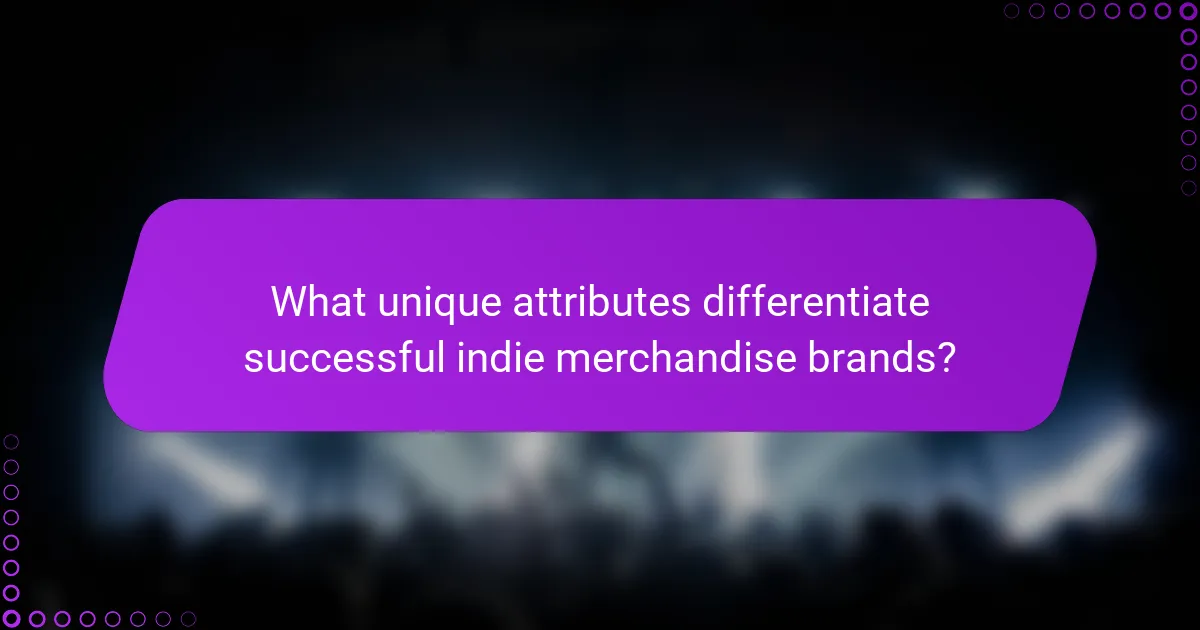
What unique attributes differentiate successful indie merchandise brands?
Successful indie merchandise brands differentiate themselves through unique designs, community engagement, and sustainable practices. They often prioritize authenticity, reflecting the values of their artists and fans. Additionally, innovative marketing strategies, such as collaborations and limited editions, enhance their appeal. These attributes foster a strong brand identity and customer loyalty, setting them apart in a competitive market.
Which branding strategies resonate most with indie music fans?
Indie music fans resonate with branding strategies that emphasize authenticity, community engagement, and unique designs. Personalized merchandise, eco-friendly materials, and limited edition items enhance emotional connections with fans. Collaborations with local artists and transparent storytelling further strengthen brand loyalty.
How do collaborations with local artists enhance merchandise appeal?
Collaborations with local artists significantly enhance merchandise appeal by adding authenticity and unique designs. These partnerships create a personal connection between the artist’s community and fans, leading to increased sales. Local artists often infuse regional culture and creativity into the merchandise, making it more relatable. This uniqueness can differentiate products in a saturated market, attracting consumers seeking original items. Additionally, collaborations can leverage the artist’s existing fanbase, expanding the merchandise’s reach and visibility.
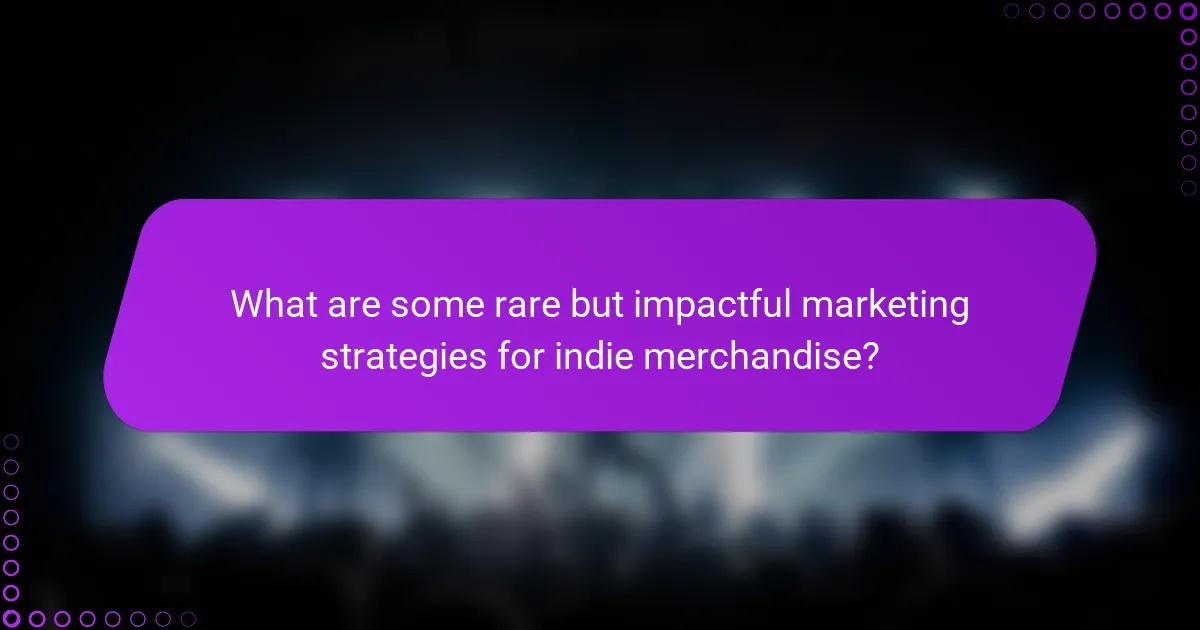
What are some rare but impactful marketing strategies for indie merchandise?
Unique marketing strategies for indie merchandise include personalized packaging, limited edition items, and collaborations with local artists. These approaches create exclusivity and foster community engagement. Utilizing social media storytelling can also enhance brand loyalty. Additionally, interactive pop-up events allow fans to connect directly with the merchandise and the artists, creating memorable experiences that drive sales.
How can limited edition releases create buzz among fans?
Limited edition releases create buzz among fans by fostering exclusivity and urgency. Fans feel a strong desire to own unique merchandise, driving demand and engagement. These releases often feature distinctive designs or collaborations, enhancing their appeal. Additionally, the limited availability encourages social sharing, amplifying the excitement within fan communities.
What role do fan engagement initiatives play in merchandise success?
Fan engagement initiatives significantly enhance merchandise success by fostering brand loyalty and increasing sales. Engaging fans through social media, exclusive content, and live events creates a personal connection, driving merchandise purchases. For example, limited-edition items and collaborations with artists can leverage fan excitement, resulting in higher demand. Additionally, data shows that artist-driven campaigns can boost merchandise sales by up to 50%. These initiatives transform casual listeners into dedicated supporters, ultimately benefiting the indie music merchandise market.
What best practices should indie artists follow for successful merchandise sales?
Indie artists should prioritize building a strong brand identity, leveraging social media, and offering unique merchandise. Engaging with fans through exclusive products enhances loyalty. Artists should also consider limited editions and collaborations to create a sense of urgency and exclusivity. Utilizing platforms that cater specifically to indie artists can streamline sales and distribution.
